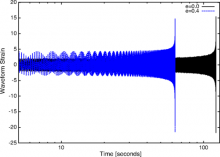
Abstract
Compact binaries that emit gravitational waves in the sensitivity band of ground-based detectors can have non-negligible eccentricities just prior to merger, depending on the formation scenario. We develop a purely analytic, frequency-domain model for gravitational waves emitted by compact binaries on orbits with small eccentricity, which reduces to the quasicircular post-Newtonian approximant TaylorF2 at zero eccentricity and to the postcircular approximation of Yunes et al. [Phys. Rev. D 80, 084001 (2009)] at small eccentricity. Our model uses a spectral approximation to the (post-Newtonian) Kepler problem to model the orbital phase as a function of frequency, accounting for eccentricity effects up to O(e^8) at each post-Newtonian order. Our approach accurately reproduces an alternative time-domain eccentric waveform model for e<0.4 nd binaries with total mass < 12 Msun. As an application, we evaluate the signal amplitude that eccentric binaries produce in different networks of existing and forthcoming gravitational waves detectors. Assuming a population of eccentric systems containing black holes and neutron stars that is uniformly distributed in comoving volume, we estimate that second-generation detectors like Advanced LIGO could detect approximately 0.1–10 events per year out to redshit z~ 0.2 , while an array of Einstein Telescope detectors could detect hundreds of events per year to redshift 2.3